Sharp EL520WBBK Handleiding
Sharp
Rekenmachine
EL520WBBK
Bekijk gratis de handleiding van Sharp EL520WBBK (8 pagina’s), behorend tot de categorie Rekenmachine. Deze gids werd als nuttig beoordeeld door 156 mensen en kreeg gemiddeld 4.5 sterren uit 78.5 reviews. Heb je een vraag over Sharp EL520WBBK of wil je andere gebruikers van dit product iets vragen? Stel een vraag
Pagina 1/8

ENGLISH
INTRODUCTION
Thank you for purchasing the SHARP Scientific Calculator Model
EL-520W.
About the calculation examples (including some formulas and
tables), refer to the reverse side of this English manual. Refer to
the number on the right of each title in the manual for use.
After reading this manual, store it in a convenient location for
future reference.
Operational Notes
• Do not carry the calculator around in your back pocket, as it
may break when you sit down. The display is made of glass
and is particularly fragile.
• Keep the calculator away from extreme heat such as on a car
dashboard or near a heater, and avoid exposing it to exces-
sively humid or dusty environments.
• Since this product is not waterproof, do not use it or store it
where fluids, for example water, can splash onto it. Raindrops,
water spray, juice, coffee, steam, perspiration, etc. will also
cause malfunction.
• Clean with a soft, dry cloth. Do not use solvents or a wet cloth.
• Do not drop it or apply excessive force.
• Never dispose of batteries in a fire.
• Keep batteries out of the reach of children.
• This product, including accessories, may change due to up-
grading without prior notice.
NOTICE
• SHARP strongly recommends that separate permanent
written records be kept of all important data. Data may be
lost or altered in virtually any electronic memory product
under certain circumstances. Therefore, SHARP assumes
no responsibility for data lost or otherwise rendered unusable
whether as a result of improper use, repairs, defects, battery
replacement, use after the specified battery life has expired,
or any other cause.
• SHARP will not be liable nor responsible for any incidental or
consequential economic or property damage caused by
misuse and/or malfunctions of this product and its peripherals,
unless such liability is acknowledged by law.
♦Press the RESET switch (on the back), with the tip of a ball-
point pen or similar object, only in the following cases. Do not
use an object with a breakable or sharp tip. Note that pressing
the RESET switch erases all data stored in memory.
• When using for the first time
• After replacing the batteries
• To clear all memory contents
•
When an abnormal condition occurs and all keys are inoperative.
If service should be required on this calculator, use only a SHARP
servicing dealer, SHARP approved service facility, or SHARP
repair service where available.
Hard Case
DISPLAY
•
During actual use, not all symbols are displayed at the same time.
• Certain inactive symbols may appear visible when viewed from
a far off angle.
• Only the symbols required for the usage under instruction are
shown in the display and calculation examples of this manual.
/
:
Appears when the entire equation cannot be displayed.
Press
<
/
>
to see the remaining (hidden) section.
xy/r
θ
:Indicates the mode of expression of results in the com-
plex calculation mode.
:Indicates that data can be visible above/below the
screen. Press to scroll up/down the view.[ ]/
2ndF : Appears when @ is pressed.
HYP : Indicates that h has been pressed and the hyper-
bolic functions are enabled. If are pressed,@H
the symbols “ ” appear, indicating that inverse2ndF HYP
hyperbolic functions are enabled.
ALPHA :
Appears when
K
(STAT VAR),
O
or
R
is pressed.
PRINTED IN CHINA / IMPRIMÉ EN CHINE / IMPRESO EN CHINA
04CGK (TINSE0730EHZZ)
SCIENTIFIC CALCULATOR
OPERATION MANUAL
EL-520W
MODEL
FIX/SCI/ENG: Indicates the notation used to display a value.
DEG/RAD/GRAD: Indicates angular units.
STAT
:Appears when statistics mode is selected.
M : Indicates that a value is stored in the independent memory.
?:
Indicates that the calculator is waiting for a numerical
value to be entered, such as during simulation calculation.
:Appears when the calculator shows an angle as the result
in the complex calculation mode.
i:Indicates an imaginary number is being displayed in the
complex calculation mode.
BEFORE USING THE CALCULATOR
Key Notation Used in this Manual
In this manual, key operations are described as follows:
To specify ex:@e
To specify ln : I
To specify F : Kü
Functions that are printed in orange above the key require to@
be pressed first before the key. When you specify the memory,
press K first. Numbers for input value are not shown as keys,
but as ordinary numbers.
Power On and Off
Press ª to turn the calculator on, and @F to turn it off.
Clearing the Entry and Memories
Operation Entry M A-F, X, Y STAT*1
(Display) F1-F4 ANS STAT VAR*2
ª× × ×
@c ×
Mode selection ×
@∏00*3
@∏10*4
RESET switch
: Clear × : Retain
*1Statistical data (entered data).
*2x¯, sx,
σ
x n, ,
Σ
x,
Σ
x2
, ¯y, sy,
σ
y,
Σ
y,
Σ
y2,
Σ
xy, r a b c, , , .
*3All variables are cleared.
*4This key combination functions the same as the RESET switch.
[Memory clear key]
Press @∏ to display the menu.
• To clear all variables (M, A-F, X, Y, ANS,
F1-F4, STAT VAR), press or 00 0®.
• To RESET the calculator, press 10 or 1®.
The RESET operation will erase all data stored in memory, and
restore the calculator's default setting.
Entering and Correcting the Equation
[Cursor keys]
• Press < or > to move the cursor. You can also return to
the equation after getting an answer by pressing > (<).
See the next section for using the and keys.[ ]
• See ‘SET UP menu’ for cursor use in the SET UP menu.
[Insert mode and Overwrite mode in the Equation display]
• Pressing @‘ switches between the two editing modes:
insert mode (default); and overwrite mode. A triangular cursor
indicates that an entry will be inserted at the cursor, while the
rectangular cursor indicates to overwrite preexisting data as you
make entries.
• To insert a number in the insert mode, move the cursor to the
place immediately after where you wish to insert, then make a
desired entry. In the overwrite mode, data under the cursor will
be overwritten by the number you enter.
• The mode set will be retained until the next RESET operation.
[Deletion key]
• To delete a number/function, move the cursor to the number/
function you wish to delete, then press . If the cursor isd
located at the right end of an equation, the key will functiond
as a back space key.
Multi-line Playback Function
Previous equations may be recalled in the normal mode. Equations
also include calculation ending instructions such as “=” and a maxi-
mum of 142 characters can be stored in memory. When the memory
is full, stored equations are deleted in the order of the oldest first.
Pressing [ will display the previous equation and the answer.
Further pressing will display preceding equations (after re-[
turning to the previous equation, press to view equations in]
order). In addition, @[ can be used to jump to the oldest
equation.
• To edit an equation after recalling it, press > < ( ).
• The multi-line memory is cleared by the following operations:
@c, @F (including the Automatic Power Off fea-
ture), mode change, memory clear ( ), RESET, @∏ @
` K R ?, ( ) , constant calculation, differential/inte-
gral calculation, chain calculation, angle unit conversion, coordi-
nate conversion, N-base conversion, numerical value storage to
the temporary memories and independent memory, solver func-
tion and simulation calculation.
MEM
RESET
0
1
Priority Levels in Calculation
Operations are performed according to the following priority:
Q Fractions (1l4, etc.) , engineering prefixes FunctionsW ∠E
preceded by their argument (x-1, x2, n!, etc.) R Yx, x¿ T Implied
multiplication of a memory value (2Y, etc.) Functions followed byY
their argument (sin, cos, etc.) Implied multiplication of a functionU
(2sin30, etc.) I n r n rC , P O×, ÷P +, –{ AND } OR, XOR, XNOR
q =, M+, M–, ⇒ → θ →M, | | |DEG, RAD, GRAD, DATA, CD, r , xy
and other calculation ending instructions
•If parentheses are used, parenthesized calculations have prec-
edence over any other calculations.
INITIAL SET UP
Mode Selection
m0: Normal mode (NORMAL)
m1: Statistic mode (STAT)
m2: Equation mode (EQN)
m3: Complex number mode (CPLX)
SET UP menu
Press ” to display the SET UP menu.
•A menu item can be selected by:
•moving the flashing cursor by using
><, then pressing ® = ( key), or
•pressing the number key corresponding to the menu item number.
•If or is displayed on the screen, press or to[ ]
view the previous/next menu screen.
•Press ª to exit the SET UP menu.
[Determination of the Angular Unit]
The following three angular units (degrees, radians, and grads) can
be specified.
• °DEG ( ) : Press ”00.
•RAD (rad) : Press ”01.
•GRAD (g) : Press ”02.
[Selecting the Display Notation and Decimal Places]
Four display notation systems are used to display calculation re-
sults: Floating point; Fixed decimal point; Scientific notation; and
Engineering notation.
•When the FIX, SCI, or ENG symbol is displayed, the number of decimal
places (TAB) can be set to any value between 0 and 9. Displayed
values will be reduced to the corresponding number of digits.
[Setting the Floating Point Numbers System in Scientific Notation]
Two settings are used to display a floating point number: NORM1
(default setting) and NORM2. A number is automatically displayed
in scientific notation outside a preset range:
•NORM1: 0.000000001 ≤ ≤ x 9999999999
•NORM2: 0.01 ≤ ≤ x 9999999999
SCIENTIFIC CALCULATIONS
•Press m0 to select the normal mode.
•In each example, press ª to clear the display. If the FIX, SCI,
or ENG indicator is displayed, clear the indicator by selecting
‘ ’NORM1 from the SET UP menu.
Arithmetic Operations
•The closing parenthesis ) = ; just before or may be
omitted.
Constant Calculations
•In constant calculations, the addend becomes a constant. Sub-
traction and division are performed in the same manner. For
multiplication, the multiplicand becomes a constant.
•In the constants calculations, constants will be displayed as K.
Functions
•Refer to the calculation examples of each function.
•Before starting calculations, specify the angular unit.
Differential/Integral Functions
Differential and integral calculations are only available in the nor-
mal mode. For calculation conditions such as the value in differ-x
ential calculation or the initial point in integral calculation, only
numerical values can be entered and equations such as 22 cannot
be specified. It is possible to reuse the same equation over and
over again and to recalculate by only changing the conditions with-
out re-entering the equation.
•Performing a calculation will clear the value in the X memory.
•
When performing a differential calculation, enter the formula first and
then enter the x value in differential calculation and the minute interval
(dx). If a numerical value is not specified for minute interval,
x
≠0 will be
x
×10
–5
and
x
=0 will be 10
–5
from the value of the numeric derivative.
•When performing an integral calculation, enter the formula first
and then enter a range of integral ( ) and subintervals (n). If aa, b
numerical value is not specified for subintervals, calculation will
be performed using n=100.
Since differential and integral calculations are performed based on
the following equations, correct results may not be obtained, in
certain rare cases, when performing special calculations that con-
tain discontinuous points.
DRG
FSE
TA B
0 1
Exponent
Equation→
Display
Mantissa
←Symbol

Integral calculation (Simpson s rule):’
S= )+4{ )+ +3 )+ +(N 1) )}—h a{ (ƒ ƒ( +a h ƒ(a h ······+ (ƒa–h
+2{ +2 )+ +4 )+ +(N 2) )}+ )}ƒ(a h ƒ(a h ······+ (ƒa–h f b(
Differential calculation:
[When performing integral calculations]
Integral calculations, depending on the
integrands and subintervals included, require
longer calculation time. During calculation, “Cal-
culating!” will be displayed. To cancel calcula-
tion, press ª. Note that there will be greater
integral errors when there are large fluctua-
tions in the integral values during minute shift-
ing of the integral range and for periodic func-
tions, etc., where positive and negative inte-
gral values exist depending on the interval.
For the former case, divide integral intervals
as small as possible. For the latter case,
separate the positive and negative values.
Following these tips will allow results of calculations with greater
accuracy and will also shorten the calculation time.
Random Function
The Random function has four settings for use in the normal or
statistics mode. (This function cannot be selected while using the
N-Base function.) To generate further random numbers in succes-
sion, press . Press to exit.® ª
•The generated pseudo-random number series is stored in memory
Y. Each random number is based on a number series.
[Random Numbers]
A pseudo-random number, with three significant digits from 0 up to
0.999, can be generated by pressing @`0®.
[Random Dice]
To simulate a die-rolling, a random integer between 1 and 6 can be
generated by pressing @`1®.
[Random Coin]
To simulate a coin flip, 0 (head) or 1 (tail) can be randomly gener-
ated by pressing @`2®.
[Random Integer]
An integer between 0 and 99 can be generated randomly by press-
ing @`3®.
Angular Unit Conversions
Each time
@g
are pressed, the angular unit changes in sequence.
Memory Calculations
Mode ANS M, F1-F4 A-F, X, Y
NORMAL
STAT × ×
EQN ×××
CPLX ×
: Available × : Unavailable
[Temporary memories (A-F, X and Y)]
Press O and a variable key to store a value in memory.
Press R and a variable key to recall a value from the memory.
To place a variable in an equation, press and a variable key.K
[Independent memory (M)]
In addition to all the features of temporary memories, a value can
be added to or subtracted from an existing memory value.
Press ªOM to clear the independent memory (M).
[Last answer memory (ANS)]
The calculation result obtained by pressing = or any other
calculation ending instruction is automatically stored in the last
answer memory.
[Formula memories (F1-F4)]
Formulas up to 256 characters in total can be stored in F1 - F4.
(Functions such as sin, etc., will be counted as one letter.) Storing
a new equation in each memory will automatically replace the
existing equation.
Note:
•Calculation results from the functions indicated below are auto-
matically stored in memories X or Y replacing existing values.
•Random function ...... Y memory
•→ θ → θr, xy ....................X memory (r x or ), Y memory ( or y)
•Use of R K or will recall the value stored in memory using
up to 14 digits.
Chain Calculations
•The previous calculation result can be used in the subsequent
calculation. However, it cannot be recalled after entering multiple
instructions.
•When using postfix functions (¿ , sin, etc.), a chain calculation is
possible even if the previous calculation result is cleared by the
use of the keys.ª or @c
Fraction Calculations
Arithmetic operations and memory calculations can be performed
using fractions, and conversion between a decimal number and a
fraction.
•If the number of digits to be displayed is greater than 10, the
number is converted to and displayed as a decimal number.
Binary, Pental, Octal, Decimal, and Hexadecimal
Operations (N-Base)
Conversions can be performed between N-base numbers. The
four basic arithmetic operations, calculations with parentheses
and memory calculations can also be performed, along with the
logical operations AND, OR, NOT, NEG, XOR and XNOR on
binary, pental, octal and hexadecimal numbers.
Conversion to each system is performed by the following keys:
@ê (“ ” “ ” appears.), @û ( appears.), @î
(“ ” appears.), @ì (“ ” appears.), @í (“ ” “ ”, ,
“ ” “ ” and disappear.)
Note: The hexadecimal numbers A – F are entered by pressing
ß ™ L, , , ÷, l I, and , and displayed
as follows:
A → ï, B → ∫, C → ó, D → ò, E → ô, F → ö
In the binary, pental, octal, and hexadecimal systems, fractional
parts cannot be entered. When a decimal number having a frac-
tional part is converted into a binary, pental, octal, or hexadeci-
mal number, the fractional part will be truncated. Likewise, when
the result of a binary, pental, octal, or hexadecimal calculation
includes a fractional part, the fractional part will be truncated. In
the binary, pental, octal, and hexadecimal systems, negative num-
bers are displayed as a complement.
Time, Decimal and Sexagesimal Calculations
Conversion between decimal and sexagesimal numbers can be
performed, and, while using sexagesimal numbers, conversion to
seconds and minutes notation. The four basic arithmetic opera-
tions and memory calculations can be performed using the
sexagesimal system. Notation for sexagesimal is as follows:
Coordinate Conversions
•Before performing a calculation, select the angular unit.
•The calculation result is automatically stored in memories X
and Y.
• •Value of r x or : X memory Value of θ or y: Y memory
Calculations Using Physical Constants
See the quick reference card and the English manual reverse side.
A constant is recalled by pressing followed by the numberß
of the physical constant designated by a 2-digit number.
The recalled constant appears in the display mode selected with
the designated number of decimal places.
Physical constants can be recalled in the normal mode (when not
set to binary, pental, octal, or hexadecimal), equation mode, or
statistics mode.
Note: Physical constants and metric conversions are based either
on the 2002 CODATA recommended values or 1995 Edi-
tion of the Guide for the Use of the International System of“
Units (SI)” released by NIST (National Institute of Stand-
ards and Technology) or on ISO specifications.
No. Constant
01 Speed of light in vacuum
02 Newtonian constant of
gravitation
03 Standard acceleration of
gravity
04 Electron mass
05 Proton mass
06 Neutron mass
07 Muon mass
08 Atomic mass unit-kilogram
relationship
09 Elementary charge
10 Planck constant
11 Boltzmann constant
12 Magnetic constant
13 Electric constant
14 Classical electron radius
15 Fine-structure constant
16 Bohr radius
17 Rydberg constant
18 Magnetic flux quantum
19 Bohr magneton
20 Electron magnetic moment
21 Nuclear magneton
22 Proton magnetic moment
23 Neutron magnetic moment
24 Muon magnetic moment
25 Compton wavelength
26 Proton Compton wavelength
No. Constant
27 Stefan-Boltzmann constant
28 Avogadro constant
29 Molar volume of ideal gas
(273.15 K, 101.325 kPa)
30 Molar gas constant
31 Faraday constant
32 Von Klitzing constant
33 Electron charge to mass
quotient
34 Quantum of circulation
35 Proton gyromagnetic ratio
36 Josephson constant
37 Electron volt
38 Celsius Temperature
39 Astronomical unit
40 Parsec
41 Molar mass of carbon-12
42 Planck constant over 2 pi
43 Hartree energy
44 Conductance quantum
45 Inverse fine-structure constant
46 Proton-electron mass ratio
47 Molar mass constant
48 Neutron Compton wavelength
49 First radiation constant
50 Second radiation constant
51 Characteristic impedance of
vacuum
52 Standard atmosphere
degree second
minute
↔
P ( ,x y )
X
Y
0
y
x
P (r,
θ
)
X
Y
0
r
θ
Rectangular coord. Polar coord.
y
x
b
xx
xx
a
0
1 3
2
y
ab
x x
x
x
x
10
2
3
f x f x( + )–– – (– ––)
dx
2
dx
2
f x’( ) =————————
dx
N=2n
h=b a–
N
a x b≤ ≤
1
3
——

Metric Conversions
See the quick reference card and the English manual reverse side.
Unit conversions can be performed in the normal mode (when not
set to binary, pental, octal, or hexadecimal), equation mode and
statistics modes.
Calculations Using Engineering Prefixes
Calculation can be executed in the normal mode (excluding N-
base) using the following 9 types of prefixes.
Modify Function
Calculation results are internally obtained in scientific notation
with up to 14 digits for the mantissa. However, since calculation
results are displayed in the form designated by the display nota-
tion and the number of decimal places indicated, the internal
calculation result may differ from that shown in the display. By
using the modify function, the internal value is converted to match
that of the display, so that the displayed value can be used
without change in subsequent operations.
Solver Function
The x value can be found that reduces an entered equation to “0”.
• This function uses Newton’s method to obtain an approxima-
tion. Depending on the function (e.g. periodic) or ‘Start’ value,
an error may occur (Error 2) due to there being no convergence
to the solution for the equation.
• The value obtained by this function may include a margin of
error. If it is larger than acceptable, recalculate the solution
after changing ‘Start’ and dx values.
• Change the ‘Start’ value (e.g. to a negative value) or valuedx
(e.g. to a smaller value) if:
• no solution can be found (Error 2).
• more than two solutions appear to be possible (e.g. a cubic
equation).
• to improve the arithmetic precision.
• The calculation result is automatically stored in the X memory.
[Performing Solver function]
Q Press m0.
W Input a formula with an x variable.
E Press ∑0.
R Input ‘Start’ value and press ®. The default value is “0”.
T Input dx value (minute interval).
Y Press ®.
SIMULATION CALCULATION (ALGB)
If you have to find a value consecutively using the same formula,
such as plotting a curve line for 2x2 + 1, or finding the variable for
2x + 2y =14, once you enter the equation, all you have to do is to
specify the value for the variable in the formula.
Usable variables: A-F, M, X and Y
Unusable functions: Random function
• Simulation calculations can only be executed in the normal
mode.
•
Calculation ending instructions other than
=
cannot be used.
Performing Calculations
QPress m0.
WInput a formula with at least one variable.
EPress @≤.
RVariable input screen will appear. Input the value of the flashing
variable, then press to confirm. The calculation result will®
be displayed after entering the value for all used variables.
• Only numerical values are allowed as variables. Input of
formulas is not permitted.
• Upon completing the calculation, press to per-@≤
form calculations using the same formula.
•Variables and numerical values stored in the memories will be
displayed in the variable input screen. To change a numerical
value, input the new value and press ®.
•Performing simulation calculation will cause memory locations
to be overwritten with new values.
STATISTICAL CALCULATIONS
Press m1 to select the statistics mode. The seven statisti-
cal calculations listed below can be performed. After selecting the
statistics mode, select the desired sub-mode by pressing the number
key corresponding to your choice.
To change statistical sub-mode, reselect statistics mode (press
m1), then select the required sub-mode.
0 (SD) : Single-variable statistics
1 (LINE) : Linear regression calculation
2 (QUAD) : Quadratic regression calculation
3 (EXP) : Exponential regression calculation
4 (LOG) : Logarithmic regression calculation
5 (PWR) : Power regression calculation
6 (INV) : Inverse regression calculation
The following statistics can be obtained for each statistical calcula-
tion (refer to the table below):
Single-variable statistical calculation
Statistics of and value of the normal probability functionQ
Linear regression calculation
Statistics of and and, in addition, estimate of for a given Q W y x
(estimate y´) and estimate of x for a given y (estimate x´)
Exponential regression, Logarithmic regression,
Power regression, and Inverse regression calculation
Statistics of and . In addition, estimate of for a given andQ W y x
estimate of for a given . (Since the calculator converts eachx y
formula into a linear regression formula before actual calculation
takes place, it obtains all statistics, except coefficients and a b,
from converted data rather than entered data.)
Quadratic regression calculation
Statistics of and and coefficients in the quadraticQ W a, , b c
regression formula ( = + + y a bx cx2). (For quadratic regression
calculations, no correlation coefficient ( ) can be obtained.) Whenr
there are two values, press x´@≠.
When performing calculations using and , only one numerica, b c
value can be held.
¯
x xMean of samples ( data)
sx Sample standard deviation (x data)
Q
σ
x xPopulation standard deviation ( data)
nNumber of samples
Σ
x xSum of samples ( data)
Σ
x2Sum of squares of samples (x data)
¯
y yMeans of samples ( data)
sy Sample standard deviation (y data)
σ
y yPopulation standard deviation ( data)
Σ
y ySum of samples ( data)
W
Σ
y2Sum of squares of samples (y data)
Σ
xy Sum of products of samples ( , )x y
rCorrelation coefficient
aCoefficient of regression equation
bCoefficient of regression equation
cCoefficient of quadratic regression equation
•Use K R and to perform a STAT variable calculation.
Data Entry and Correction
Entered data are kept in memory until or mode selec-@c
tion. Before entering new data, clear the memory contents.
[Data Entry]
Single-variable data
Data
k
Data
&
frequency
k
(To enter multiples of the same data)
Two-variable data
Data
x&
Data
yk
Data
x&
Data
y&
frequency
k (To enter multiples
of the same data and x y.)
•Up to 100 data items can be entered. With the single-variable
data, a data item without frequency assignment is counted as
one data item, while an item assigned with frequency is stored as
a set of two data items. With the two-variable data, a set of data
items without frequency assignment is counted as two data items,
while a set of items assigned with frequency is stored as a set of
three data items.
[Data Correction]
Correction prior to pressing immediately after a data entry:k
Delete incorrect data with , then enter the correct data.ª
Correction after pressing k:
Use [] to display the data previously entered.
Press ] to display data items in ascending (oldest first)
order. To reverse the display order to descending (latest first),
press the [ key.
Each item is displayed with ‘Xn=’, ‘Yn=’ ‘, or Nn=’ (n is the sequen-
tial number of the data set).
Display the data item to modify, input the correct value, then
press k. Using &, you can correct the values of the data
set all at once.
•To delete a data set, display an item of the data set to delete,
then press . The data set will be deleted.@J
•To add a new data set, press ª and input the values, then
press k.
Statistical Calculation Formulas
In the statistical calculation formulas, an error will occur when:
•The absolute value of the intermediate result or calculation result
is equal to or greater than 1 × 10100
.
•The denominator is zero.
•An attempt is made to take the square root of a negative number.
•No solution exists in the quadratic regression calculation.
Normal Probability Calculations
•P(t t t), Q( ), and R( ) will always take positive values, even when
t<0, because these functions follow the same principle used
when solving for an area.
Values for P( ), Q( ), and R( ) are given to six decimal places.t t t
SIMULTANEOUS LINEAR EQUATIONS
Simultaneous linear equation with two unknowns (2-VLE) or with
three unknowns (3-VLE) may be solved using this function.
Q 2-VLE: m20
W 3-VLE: m21
•If the determinant D = 0, an error occurs.
•If the absolute value of an intermediate result or calculation result
is 1 × 10100 or more, an error occurs.
•Coefficients ( a1, etc.) can be entered using ordinary arithmetic
operations.
•To clear the entered coefficients, press @c.
•Pressing ® when the determinant D is in the display recalls
the coefficients. Each time is pressed, a coefficient is®
displayed in the order of input, allowing the entered coefficients
to be verified (by pressing , coefficients are displayed@®
in reverse order.) To correct a particular coefficient being dis-
played, enter the correct value and then press ®.
QUADRATIC AND CUBIC EQUATION SOLVERS
Quadratic (ax2 + bx + c = 0) or cubic (ax3 + bx2 + cx + d = 0) equation
may be solved using this function.
Q Quadratic equation solver: m22
W Cubic equation solver: m23
•Press ® after entering each coefficient.
•The result will be displayed by pressing ® after entering all
coefficients. When there are more than 2 results, the next solu-
tion will be displayed.
• “ ”When the result is an imaginary number, xy symbol will appear.
The display can be switched between imaginary and real parts
by pressing @≠.
COMPLEX NUMBER CALCULATIONS
To carry out addition, subtraction, multiplication, and division using
complex numbers, press m3 to select the complex number
mode.
Results of complex number calculations are expressed in two modes:
Q@}: Rectangular coordinate mode (xy appears.)
W@{: Polar coordinate mode (
r
θ
appears.)
Complex number entry
QRectangular coordinates
x-coordinate
+
y-coordinate
Ü
or
x-coordinate
+Ü
y-coordinate
WPolar coordinates
r
Ö
θ
r: absolute value θ: argument
•On selecting another mode, the imaginary part of any complex
number stored in the independent memory (M) will be cleared.
•A complex number expressed in rectangular coordinates with the
y-value equal to zero, or expressed in polar coordinates with the
angle equal to zero, is treated as a real number.
•Press ∑0 to return the complex conjugate of the speci-
fied complex number.
ERROR AND CALCULATION RANGES
Errors
An error will occur if an operation exceeds the calculation ranges,
or if a mathematically illegal operation is attempted. When an error
occurs, pressing (or ) automatically moves the cursor< >
back to the place in the equation where the error occurred. Edit the
equation or press to clear the equation. ª
Error Codes and Error Types •Make sure that the display
display does not appear as
Type Regression formula
Linear y = a + bx
Exponential y = a e •bx
Logarithmic y = a + b x • ln
Power y = a x •b
Inverse y = a + b —
Quadratic y = a + bx + cx2
1
x
No. Remarks
1 in : inch
2 cm : centimeter
3 ft : foot
4 m : meter
5 yd : yard
6 m : meter
7 mile : mile
8 km : kilometer
9 n mile : nautical mile
10 m : meter
11 acre : acre
12 m 2: square meter
13 oz : ounce
14 g : gram
15 lb : pound
16 kg : kilogram
17 °F : Degree Fahrenheit
18 °C : Degree Celsius
19 gal (US) : gallon (US)
20 l: liter
21 gal (UK) : gallon (UK)
22 l: liter
No. Remarks
23 fl oz(US): fluid ounce(US)
24 ml: milliliter
25 fl oz(UK): fluid ounce(UK)
26 ml: milliliter
27 J : Joule
28 cal : calorie
29 J : Joule
30 cal15 : Calorie (15n°C)
31 J : Joule
32 calIT : I.T. calorie
33 hp : horsepower
34 W : watt
35 ps : French horsepower
36 W : watt
37
38 Pa : Pascal
39 atm : atmosphere
40 Pa : Pascal
41 (1 mmHg = 1 Torr)
42 Pa : Pascal
43
44 J : Joule
Prefix Operation Unit
k (kilo) ∑10 103
M (Mega) ∑11 106
G (Giga) ∑12 109
T (Tera) ∑13 1012
m (milli) ∑14 10–3
µ (micro) ∑15 10–6
n (nano) ∑16 10–9
p (pico) ∑17 10–12
f (femto) ∑18 10–15
Product specificaties
| Merk: | Sharp |
| Categorie: | Rekenmachine |
| Model: | EL520WBBK |
| Soort bediening: | Knoppen |
| Kleur van het product: | Zwart |
| Gewicht: | 97 g |
| Breedte: | 79.6 mm |
| Diepte: | 154.5 mm |
| Hoogte: | 13.2 mm |
| Soort: | Wetenschappelijke rekenmachine |
| Stroombron: | Batterij/Zonne-energie |
| Automatisch uitschakelen: | Ja |
| Vormfactor: | |
| Tweede LCD-scherm: | Nee |
| Cijfers: | 12 cijfers |
| Beeldscherm kanteling: | Nee |
| Tekstregels: | 2 regels |
| Geheugenregisters: | 9 |
| Type beeldscherm: | LCD |
| Display met achtergrondverlichting: | Nee |
| Werking: | 419 |
Heb je hulp nodig?
Als je hulp nodig hebt met Sharp EL520WBBK stel dan hieronder een vraag en andere gebruikers zullen je antwoorden
Handleiding Rekenmachine Sharp
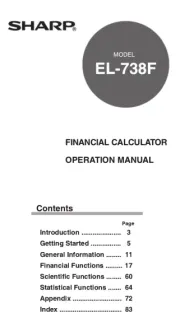
16 November 2024

18 Juni 2023

12 Juni 2023

6 Juni 2023

2 Juni 2023

19 Mei 2023

18 Mei 2023

18 Mei 2023

16 Mei 2023

14 Mei 2023
Handleiding Rekenmachine
- Rexel
- Aurora
- Victor Technology
- Ibico
- Casio
- Texas
- Sencor
- Sanyo
- Lexibook
- Q-CONNECT
- Trevi
- Genie
- Texas Instruments
- Olympia
- Basetech
Nieuwste handleidingen voor Rekenmachine
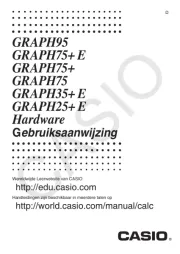
2 September 2025
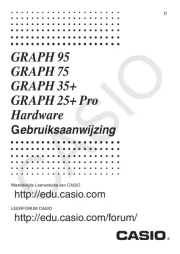
2 September 2025
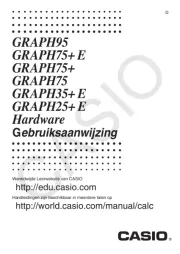
2 September 2025
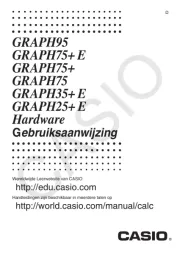
2 September 2025

9 Augustus 2025
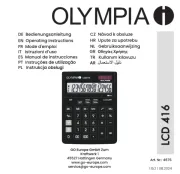
5 Augustus 2025
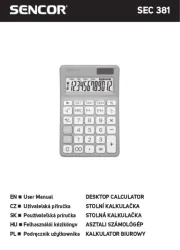
29 Juli 2025
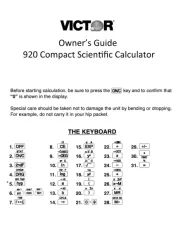
9 Juni 2025

7 Juni 2025
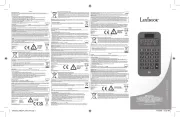
7 Juni 2025